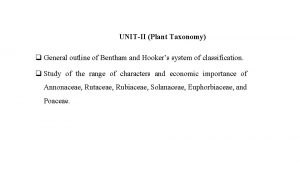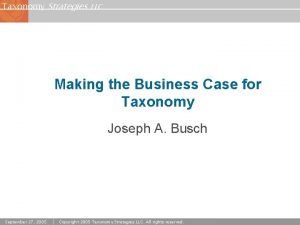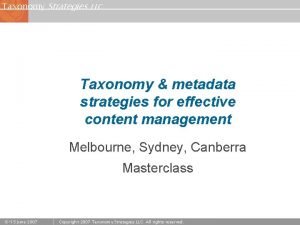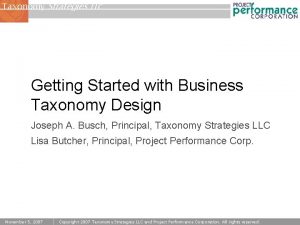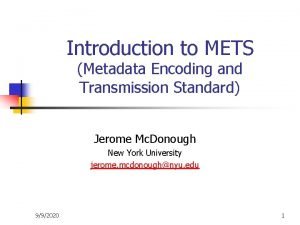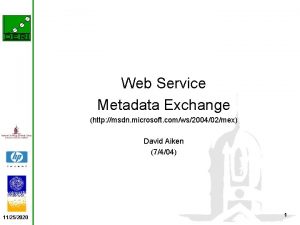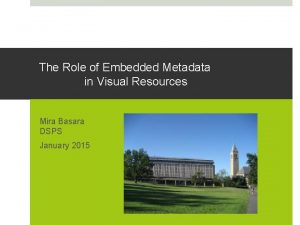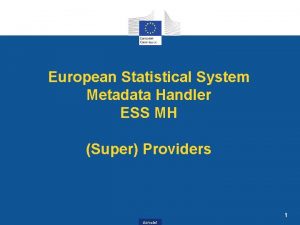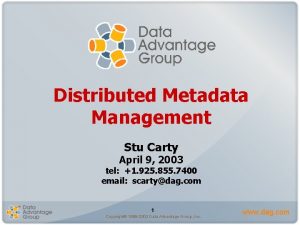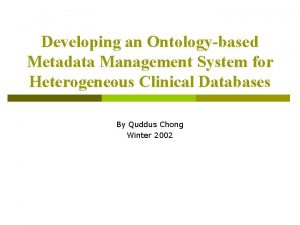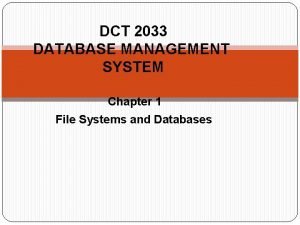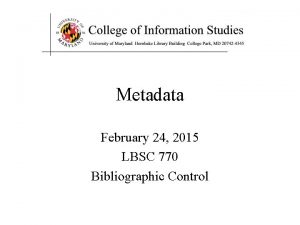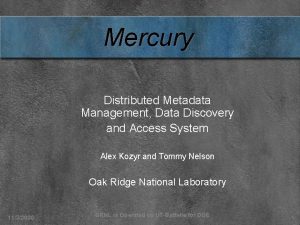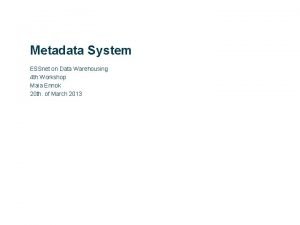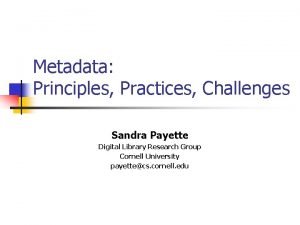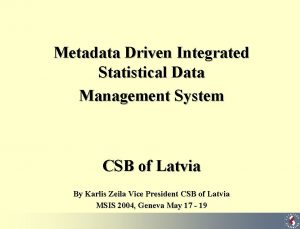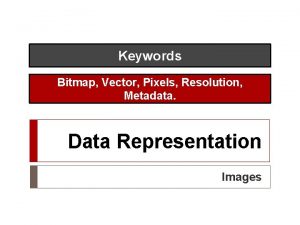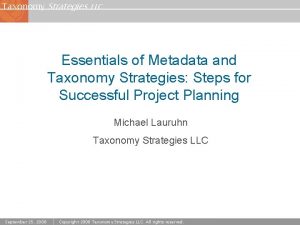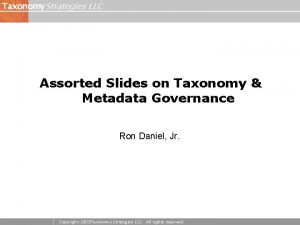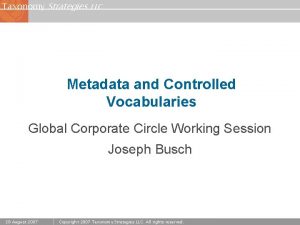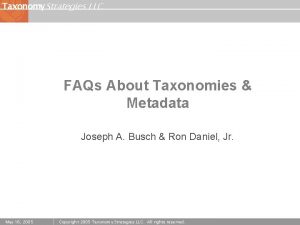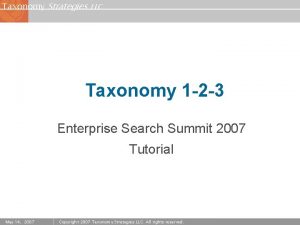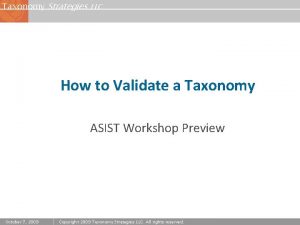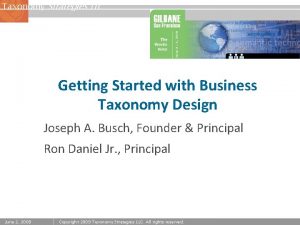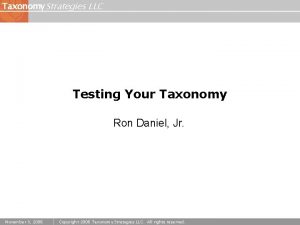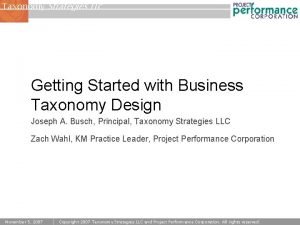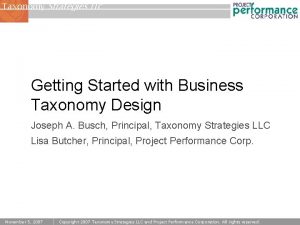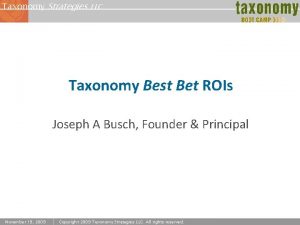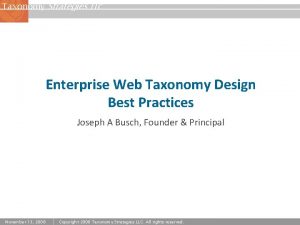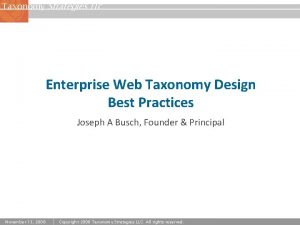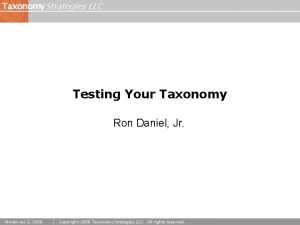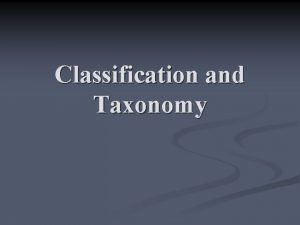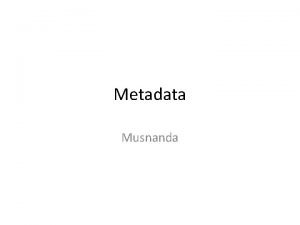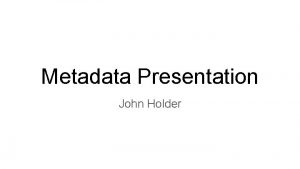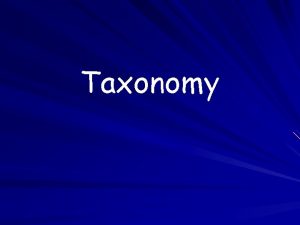Taxonomy Strategies LLC Essentials of Metadata and Taxonomy



































- Slides: 35

Taxonomy Strategies LLC Essentials of Metadata and Taxonomy Strategies: Steps for Successful Project Planning Michael Lauruhn Taxonomy Strategies LLC September 25, 2008 Copyright 2008 Taxonomy Strategies LLC. All rights reserved.

Who am I: Mike Lauruhn v Over 8 years working at Internet companies. § Member, Taxonomy Strategies § Content Intelligence Technical Specialist, CMP Media § Metadata Consultant, Interwoven § Ontologist / Category Manager, Looksmart. com v Community service. § Cataloger, California Newspaper Project § Co-President, American Library Association Student Chapter § Volunteer, Electronic Discovery Center, San Francisco Public Library Taxonomy Strategies LLC The business of organized information 2

Purpose v Identify and explain steps to help guide a taxonomy project through an organization. v Explain how to: § Build interest and support for a taxonomy project. § Build momentum and a governance model so the taxonomy doesn’t end on the “last day” of the project. (It’s more than having the “correct” taxonomy in place. ) Taxonomy Strategies LLC The business of organized information 3

Why is this important? v Taxonomy projects can be misunderstood. § “It's the new search engine. ” § “It's the new site navigation. ” § “Can't we just use the site map? ” § “Luxury. . . but not an essential project. ” v Taxonomy projects can be expensive. § Involves participation from many resources. § Multiple meetings and iterations. § Can involve multiple IT applications. – Search engine, DAM, CMS, etc. § Legacy content tagging and migration projects. Taxonomy Strategies LLC The business of organized information 4

Topics v Defining succinct use cases. v Making the case to management. v Understanding your audience, content and technology. v Build a usable and durable taxonomy. v Communications, education and marketing. v Planning, governance and maintenance. Taxonomy Strategies LLC The business of organized information 5

Topics v Defining succinct use cases. v Making the case to management. v Understanding your audience, content and technology. v Build a usable and durable taxonomy. v Communications, education and marketing. v Planning, governance and maintenance. Taxonomy Strategies LLC The business of organized information 6

Defining Use Cases v Use cases should be: § Tangible and specific. § Relevant to your organization. § Measurable. § Focused. • Pick one or two applications and describe a pain point. v Avoid: § Vague and open-ended use cases. – “It’ll improve the search. ” § The temptation to start with large-scale enterprise-wide use cases. Taxonomy Strategies LLC The business of organized information 7

Defining Use Cases v Be specific with use cases: § This will give our account managers to ability to find all the assets we’ve created for a particular customer. § This will allow artists the ability to find examples of other print advertisements generated for a given demographic. § Content creators can use this to find templates used for similar communications to the one they are working on. Taxonomy Strategies LLC The business of organized information 8

Defining Use Cases v Benefits of succinct Use Cases § Keeps the taxonomy focused. § Provides goals that stakeholders can indentify. § Makes it easy to describe to colleagues and sponsors. Taxonomy Strategies LLC The business of organized information 9

Topics v Defining succinct use cases. v Making the case to management. v Understanding your audience, content and technology. v Build a usable and durable taxonomy. v Communications, education and marketing. v Planning, governance and maintenance. Taxonomy Strategies LLC The business of organized information 10

Making the case to management Identify savings to the bottom line: v Efficiencies to existing business process. § “It will save time. ” v Better utilization of tools. § “We will get more use from our repository and storage. ” v Lower risk. § “This will help us get better control over our clients’ intellectual property. ” Taxonomy Strategies LLC The business of organized information 11

Making the case to management v Re-state use cases: v This will give our account managers to ability to find all the assets we’ve created for a particular customer. § “This will give us better control over Intellectual Property. ” v This will allow artists the ability to find examples of other print advertisements generated for a given demographic. § “This will save hours and contribute to the creative process. ” v Content creators can use this to find templates used for similar communications to the one they are working on. § “This will save hours of searching and recreating content. ” Taxonomy Strategies LLC The business of organized information 12

Making the case to management v Benefits of communicating to management § Support for the immediate project. § Can help identify similar projects to leverage the taxonomy. § Makes is easier to justify expansion and future initiatives. Taxonomy Strategies LLC The business of organized information 13

Topics v Defining succinct use cases. v Making the case to management. v Understanding your audience, content and technology. v Build a usable and durable taxonomy. v Communications, education and marketing. v Planning, governance and maintenance. Taxonomy Strategies LLC The business of organized information 14

Understanding your audience v Does the taxonomy make sense to: § The resources who will be tagging the assets? § The resources who use and search for the assets? v Getting their buy-in: § Re-affirm the use cases. § Interview during the taxonomy development process. § Incorporate them into review cycles. § Use existing terminology. Taxonomy Strategies LLC The business of organized information 15

Understanding your technology v What metadata does the technology support? § Does the software automatically assign technical metadata that can be used? Size, color, scale, formats, etc. v What are the vocabulary elements that will be supported? § Will the taxonomy require: » Hierarchies? » Relationships between vocabularies? » Synonyms and alt terms? Taxonomy Strategies LLC The business of organized information 16

Understanding your content v How will the metadata be assigned to the assets and content? v How easy is it to tag or re-tag the content? v How accessible is the metadata and how can it be reused or deployed? Taxonomy Strategies LLC The business of organized information 17

Understanding your audience, content & technology v Benefits § Internal anticipation and support for the immediate projects. § Avoids surprises for technical implementation. § Prevents superfluous taxonomy development and identifies unsupported functionality. § Avoids surprises for asset owners and content users. Taxonomy Strategies LLC The business of organized information 18

Topics v Defining succinct use cases. v Making the case to management. v Understanding your audience, content and technology. v Build a usable and durable taxonomy. v Communications, education and marketing. v Planning, governance and maintenance. Taxonomy Strategies LLC The business of organized information 19

The faceted taxonomy v Discrete branches of a taxonomy. v Consistent, extensible sets of attributes for labeling content and content components. Benefits: • Easier to maintain. • Easier to tag by content owners. • Can be easier to navigate. Main Ingredients • • • Taxonomy Strategies LLC The business of organized information Chocolate Dairy Fruits Grains Meat & Seafood Nuts Olives Pasta Spices & Seasonings Vegetables Meal Type • • • Breakfast Brunch Lunch Supper Dinner Snack Cooking Methods Cuisines • • • African American Asian Caribbean Continental Eclectic/ Fusion/ International Jewish Latin American Mediterranean Middle Eastern Vegetarian • • • • Advanced Bake Broil Fry Grill Marinade Microwave No Cooking Poach Quick Roast Sauté Slow Cooking • Steam • Stir-fry 20

Some examples of facets v Functional Context: Content Type: Audio Recording Banner Ad Brochure Photograph Print Advertisement Public Service Announcement … Function: Marketing Sales Legal Safety … Taxonomy Strategies LLC The business of organized information 21

Some examples of facets v Who is the asset for? Industries & Vertical Markets: Aerospace Automotive Healthcare Information Technology Retail … Audience & Demographics: Veterans College students Families Active Military … Taxonomy Strategies LLC The business of organized information 22

Some examples of facets v Proper names: § Clients & Partners § Products & Services § Place names § People Taxonomy Strategies LLC The business of organized information 23

Faceted taxonomy v Refer to the Use Cases when defining the facets. § This will give our account managers to ability to find all the assets we’ve created for a particular customer. § This will allow artists the ability to find examples of other print advertisements generated for a given demographic. § Content creators can use this to find templates used for similar communications to the one they are working on. Taxonomy Strategies LLC The business of organized information 24

Build a usable and durable taxonomy v Benefits § Easier to maintain than a single comprehensive taxonomy. § Easy to use for tagging. § Allows for narrowing and expanding of searches. Taxonomy Strategies LLC The business of organized information 25

Topics v Defining succinct use cases. v Making the case to management. v Understanding your audience, content and technology. v Build a usable and durable taxonomy. v Communications, education and marketing. v Planning, governance and maintenance. Taxonomy Strategies LLC The business of organized information 26

Communications, Education & Marketing v Engage stakeholders and content owners v Hold meetings and ongoing dialog: § Re-affirm the use cases. § Interview during the taxonomy development process. § Incorporate them into review cycles. § Keep stakeholders up to date about process and workflow changes. Taxonomy Strategies LLC The business of organized information 27

Communications, Education & Marketing v Encourage content owners and users to participate in taxonomy validation exercises. v Sample tagging exercises with screenshots and spreadsheets of the taxonomy. § Helps build confidence and familiarity. § Final opportunity for feedback and questions. Taxonomy Strategies LLC The business of organized information 28

Communications, Education & Marketing v Benefits § Engaged users will be supportive and not surprised. § Training will be less intensive for users. § Users will understand processes and feedback mechanisms. Taxonomy Strategies LLC The business of organized information 29

Topics v Defining succinct use cases. v Making the case to management. v Understanding your audience, content and technology. v Build a usable and durable taxonomy. v Communications, education and marketing. v Planning, governance and maintenance. Taxonomy Strategies LLC The business of organized information 30

Taxonomy Roadmap v Identifies ways key business functions organize and store information so it can be found and used later. v Makes recommendations on how to use these methods into common information organization practices. v Provides the governance model to facilitate development and maintenance of the taxonomy. Taxonomy Strategies LLC The business of organized information 31

Planning, governance & maintenance v The taxonomy is not “locked down” upon implementation. v Taxonomy will need to grow and evolve, but in predictable way. v Taxonomy governance will help manage the taxonomy and answer questions: § How can content users make suggestions? § Who is responsible for adding new terms? § How do verdicts get reached? § When does an update taxonomy get released? § What if there is an urgent update needed? Taxonomy Strategies LLC The business of organized information 32

Planning, governance & maintenance v Components of taxonomy governance may include: § Taxonomy governance team. § Team charter. § Multiple change request processes. § Communications model. v Duties include: § Log change requests. § Communicate changes. § Taxonomy release schedule. § Develop & maintain documentation. § Prepare training materials. Taxonomy Strategies LLC The business of organized information 33

Planning, governance & maintenance v Benefits § Taxonomy owners will have documented processes for decisions. § Users will understand processes and feedback mechanisms. § IT administrators and content owners know who can make changes to the taxonomy. Taxonomy Strategies LLC The business of organized information 34

Taxonomy Strategies LLC Questions? Michael Lauruhn, +1 -415 -378 -2747 mlauruhn@taxonomystrategies. com www. taxonomystrategies. com September 25, 2008 Copyright 2008 Taxonomy Strategies LLC. All rights reserved.
 Metadata and taxonomy
Metadata and taxonomy Metadata and taxonomy
Metadata and taxonomy Bubonic plague
Bubonic plague Business taxonomy
Business taxonomy Kendall taxonomy
Kendall taxonomy Taxonomy strategies
Taxonomy strategies Taxonomy strategies
Taxonomy strategies Metadata encoding and transmission standard (mets)
Metadata encoding and transmission standard (mets) Metadata lifecycle
Metadata lifecycle Web service metadata
Web service metadata Paradata vs metadata
Paradata vs metadata What is embedded metadata
What is embedded metadata Fido metadata service
Fido metadata service Eurostat metadata
Eurostat metadata What is metadata in database
What is metadata in database Api driven ddi
Api driven ddi Federated metadata management
Federated metadata management Ess metadata handler
Ess metadata handler Etl metadata
Etl metadata Distributed metadata management
Distributed metadata management Clinical metadata management tool
Clinical metadata management tool Dbms manages the interaction between and database
Dbms manages the interaction between and database Metadata management framework
Metadata management framework Eap data lake
Eap data lake Metadata
Metadata Metadata management wiki
Metadata management wiki Metadata
Metadata Distributed metadata management
Distributed metadata management Metadata layer data warehouse
Metadata layer data warehouse Metadata principles
Metadata principles Metadata-driven data management
Metadata-driven data management Metadata
Metadata Metadata lifecycle
Metadata lifecycle What is metadata
What is metadata Read exif metadata from photos
Read exif metadata from photos Metadata of encrypted traffic analytics eta
Metadata of encrypted traffic analytics eta
